Miravis Top’s light-energy and water-conservation benefits are a boon for soybean yields
Soybean growers have come to expect superb disease control from modern fungicides, but when a product like Miravis® Top can further amplify yields by incorporating plant-health benefits into the chemistry, growers get a more complete approach to having a successful harvest.
“We have completely switched to Miravis Top on all of our bean ground,” said Sam Dunkmann, who has about 1,600 acres of soybeans on his farm in St. Peters, Missouri. “I’ve done a lot of trials, and Miravis Top was always either the winner or at the top of the group. It proved itself for us on our farm.”
Miravis Top was registered by the U.S. Environmental Protection Agency in 2018 and has shown itself as the embodiment of the company’s “Cleaner and Greener” approach to crop protection.
“Cleaner” encapsulates the disease-control aspect that most growers and retailers would be familiar with from a fungicide — Miravis Top is adept at combatting diseases such as frogeye leaf spot, aerial web blight, target spot, and brown spot.
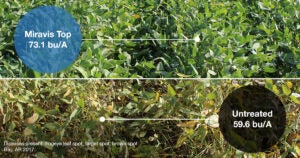
The “Greener” aspect ties into several underlying plant-health benefits that Miravis Top nurtures, allowing it to stand out from its competitors and help growers achieve a robust ROI, even in years when the stress from disease is lower.
“We knew we had tons of scientific information that really validated the plant health claims. But I think where the industry had fallen short is that nobody drew the through line between all of the science and what that means to a grower,” said Logan Romines, Syngenta Row Crop Fungicide Product Marketing Lead.
While “photosynthetic capacity” and “transpiration” may not be words that roll off the tongue when discussing soybean plants, other terms like “light energy” and “water conservation” are. Those coupled with harvest efficiency help propel Miravis Top’s expanding usage throughout key sections of the U.S.
“Greener leaves capture more light,” Romines said. “So, if that plant is able to get more light, it’s got more energy to use to produce a better yield.
“And when we think about water conservation, greener also means higher water- and nutrient-use efficiency,” he said. “Available water and nutrients have a bigger impact on yield potential than you may think. When plants are fighting drought stress, it means they’re putting less energy toward yield.”
This management of abiotic and environmental stresses also impacts harvest efficiency. Healthier leaves and pods mean higher-quality crops and will position growers for a more profitable harvest with a crop that has optimal protein content, optimal moisture levels, decreased “sooty” mold secondary infection, higher vigor, and larger size soybeans.
Syngenta research has shown an average of 8 bu/A yield advantage on fields treated with Miravis Top compared with untreated fields.1
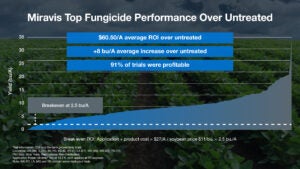
Dunkmann noted that he is usually between a 9 and 11 bu/A advantage using Miravis Top. He has seen this fungicide keep a plant alive longer, allowing varieties to reach their full potential and pay off more during harvest. Its effectiveness, he said, makes it a financially wise decision even in the face of competitor products that try to undercut pricing through rebates and bundle programs.
“The extra bushels in the end game sealed it,” Dunkmann said. “I think Syngenta is at the top of the game when it comes to fungicide chemistry.”
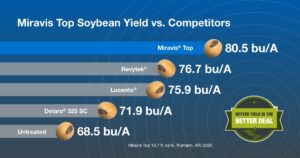
The plant-health benefits come from ADEPIDYN® technology, which is the driving SDHI molecule across the Miravis product line and helps to reduce the transpiration rate (the loss of water vapor) in leaves. That pairs with the broad-spectrum fungicide difenoconazole, which is particularly adept at targeting strobilurin-resistant frogeye leaf spot and many other difficult-to-control diseases.
And the fact that frogeye leaf spot has expanded beyond the Southern U.S. in recent years has resulted in growers in Iowa and in the southern third of Indiana and Illinois applying Miravis Top on their farms.
Romines explains that consistency increases the potential of Miravis Top, emphasizing both its preventive and curative qualities.
If a soybean grower has a high disease-pressure year, Miravis Top can deliver a solid return on investment vs. what that grower would benchmark from an untreated aspect. But even beyond that, in a season with lower disease pressures, growers can still plan to make that application, and if drought or other sub-optimal environmental conditions occur, Miravis Top is able to protect the plant thanks to its health-promoting capabilities, like greening.
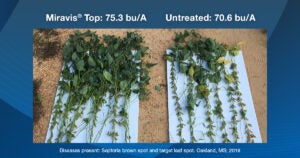
“A lot of growers will think to themselves, ‘Well, it’s a low disease-pressure environment. I don’t need to use a fungicide or I don’t need to make this Miravis Top application,’” said Romines, who has been at Syngenta since 2014. “And one of the things that we’ve started talking more about is that, because of these plant-health benefits and what you’re able to get out of a fungicide through that light-energy increase or through that water-conservation aspect, we can still help bring about robust yields.”
Growers can be confident that they’re going to get a robust ROI using Miravis Top, no matter how much disease pressure they’re facing that season. The overall benefits allow them to still catch a good yield bump.
“To me, it’s a Cadillac product as far as the chemistry,” Dunkmann said. “There’s no reason not to try it.”
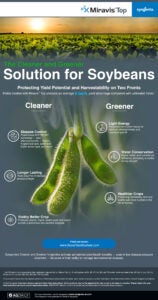
This article was published on behalf of Syngenta. Visit this page to find a Syngenta Crop Protection Specialist near you.
Ryan Tipps is the founder and managing editor of AGDAILY. He has covered farming since 2011, and his writing has been honored by state- and national-level agricultural organizations.



